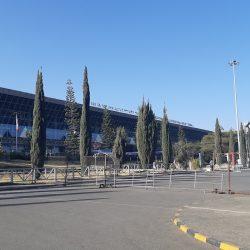
Can I use a portable or standby generator during an outage?
Although a portable generator can be a valuable tool, it can also be very dangerous if not installed or used correctly. Here are a few tips:
- Use your generator only to run specific appliances, and locate it outside so poisonous carbon monoxide fumes don’t enter your home.
- If you use a standby generator, be sure it’s professionally installed and inspected according to local and National Electric Codes (NEC).
- Always follow the manufacturer’s instructions to avoid injuring or damaging your generator or appliances.
- Never plug a generator directly into any electric outlets. Generators can feed electricity back into the power lines, putting you and our line workers in danger. Generators should only be electrically connected to the house electrical system through a professionally installed and inspected electrical transfer switch that meets local and National Electrical Codes (NEC), and that isolates the home and generator from the Electrical Utility System service to your house.
How do I prepare for an outage?
- Keep emergency supplies on hand, including:
- Flashlights with fresh batteries
- Portable, battery-powered radio
- Wind-up or battery-powered clock
- Water and nonperishable food
- Manual can opener
- Make sure cell phones and tablets are fully charged and remember, cordless phones will not work without electricity.
- Know how to manually open and close any electric garage doors, security doors or gates.
- Protect sensitive electric equipment such as computers and televisions by installing surge protectors or other power protection devices.
- It is important that customers with special medical needs or their caregivers take steps to ensure their safety by making arrangements ahead of time to prepare for potentially long-lasting interruptions in electric service. Plan ahead for storms or other service interruptions.

How do you estimate my restoration time?
Estimated restoration times fall into two categories: normal operations and storm operations. Many factors affect how we determine your estimated restoration time.
During normal operations, our system establishes an initial estimated restoration time based on historical data of post outage experience. Once a crew arrives on site and evaluates the situation, the estimated restoration time may be updated.
During storm operations, we follow five steps:
- Planning. As storms are predicted, staffing and response coordination is scheduled. PDS stands ready to restore your power as soon as it is safe to do so.
- Assess the damage. Our crews work as quickly and safely as possible to assess the damage. Through it is expected that many customers will be restored sooner, our system estimates 48 hours from the start of the event. More specific estimated times of restorations will be provided as soon as damage assessments can be completed. If you have damage to the electric service on your home, a licensed electrician may need to make repairs before we can safely restore your power.
- Restoration begins. Restoration efforts are underway as weather and safety conditions permit. Our workers will focus on restoring power to critical infrastructure first, such as transmission lines and substations, as this will restore power to larger groups of customers at once. Emergency facilities such as hospitals will also be prioritized. Assessments continue and restoration times are updated as more information becomes available.
- Restoration continues. Progress continues as we work to repair damage from the storm. Crews are working on many locations throughout the affected areas. Safety of our customers and our workers is our top priority, so we appreciate your patience as we restore power as quickly as possible.
- Restoration complete. Power has been restored to all affected customers. If your neighbors have power but you do not, please contact us on 0302 611-611.
How is power restored during a major outage?
When a major storm disrupts service to a large number of customers, our first concern is safety. During storm restoration, facilities that are essential to the health and welfare of the community are given priority — hospitals, health care providers, emergency services, public safety, water and sewage stations, and other vital community services.
After service is restored to priority customers, our strategy is to concentrate restoration efforts in the areas that restore electricity to the greatest number of people in the shortest period of time. PDS starts at the source of the power outage and works outward to restore electrical service.
When making a decision on where power should be restored first, we look at the amount of customers that are affected by the outage. If we have a choice to restore 2,000 customers or 100 customers, we would first work to get the 2,000 customers up and running.
Power has been restored to others around me, why am I still not restored?
This can occur because power circuits do not always follow streets or area geography. If you received information that power has been restored in your area and your lights are still out, please contact ECG on 0302 611611. It could be possible that you were affected by two problems and only one was corrected.
What should I do during an outage?
Turn off all the appliances you think were on before the power went out.
Use flashlights instead of candles to reduce fire hazards.
Keep your refrigerator and freezer doors closed as much as possible to prevent food spoilage. Food should stay frozen for about one full day and fresh in the refrigerator for about four hours.
Unplug your electronic equipment, including computers.
Leave a light or radio on to let you know when you have service again.
Don’t wire an emergency generator into your home electrical system. Backfeed into power lines could injure or kill a lineman working to get electricity restored.
Use your generator only to run specific appliances, and locate it outside so poisonous carbon monoxide fumes don’t enter your home.
If you see a downed power line, stay away. Treat all power lines as if they are carrying electrical current, and never touch or move one.
After an outage, wait a few minutes before turning on major electrical appliances. This will help eliminate problems that could occur if there’s a sharp increase in demand immediately after power is restored.
If you think power has been restored to your area, but your home is still without power, report your outage online or call us at (0302) 611611
What should I do if I see a downed or damaged electrical line?
Never touch or move a downed line. Stay as far away as possible and keep others away. Do not attempt to rescue someone else who has touched a downed line. Call 0302 – 611611 immediately, anytime, and we’ll send crews to handle the situation and make repairs.
What should I do if my power goes out?
If your power goes out and you have not been notified in advance, please check your electric meter. If the display shows a reading or there is a light blinking, the issue will be with credit for a prepaid meter. Get to the nearest pay point and buy credit unto your card.
If the power does not return, you can report an outage and check on outage status online. You can also call us at 0302 611611. You will be connected to our automated telephone system which will walk you through reporting your service outage. You will also have the option to speak directly with a customer service representative. Do not assume that PDS knows your power is out —PLEASE call us
Whose power gets restored first?
When a major storm disrupts service to a large number of customers, our first concern is safety. During storm restoration, facilities that are essential to the health and welfare of the community are given priority — hospitals, health care providers, emergency services, public safety, water and sewage stations, and other vital community services.
Why can’t ECG tell me when my power will be restored?
Each outage has different circumstances, and some may take longer than others to identify the source of the problem. Our crews work as quickly and safely as possible to restore your power. During widespread storm-related outages, the availability of restoration information from our crews may be significantly delayed.
In addition, there are other factors that can affect the time of power restoration: weather conditions, accessibility to damaged areas, time of day and environmental issues. Since these factors can impact outages differently, it can be difficult to predict restoration times.
Why do my lights blink during a storm or rains?
The power lines that serve your home or business have a variety of protective devices designed to keep your power on during storms and other severe weather. There are several reasons your lights might blink during a storm, but the most common cause is tree movement. Despite our best efforts to trim trees near power lines, trees may come in contact with our lines during strong winds. When that happens, your lights may dim or you may lose power for a few seconds. It’s important that our customers allow us to trim trees near power lines to minimize these types of disruptions.
Why does the power go out?
There are scheduled outages and unexpected outages.
Scheduled Outages
You may receive a notice or a phone call about a scheduled outage that will interrupt your service. It means crews will be performing maintenance or upgrading equipment that serves you or your neighborhood.
We’ll let you know a day in advance and try to be as accurate as possible, but the outage may not begin or end at the exact time. Occasionally, weather and operational issues may cancel a scheduled outage.
Unexpected Outages
Our crews work around the clock to restore service following a variety of unexpected outage causes:
Weather — Lightning, wind, rain, excessive heat/cold that may have impacted our electrical equipment.
Equipment — Wear and tear. Many things fall under this category. Could include overhead electrical equipment, underground electrical equipment and transmission equipment. This could include small connections at the customer’s residence to transmission lines that serve thousands of customers.
Miscellaneous — Mechanical damage, construction error, fire, etc.
Animal — Contact with electrical equipment.
Trees — Fallen trees, branches, tree growth into equipment.
Human — Accidents, vandalism or other human caused outages
Reference: https://www.ecggh.com/index.php/customer-service/inquiry-complaints/faqs-on-outages



